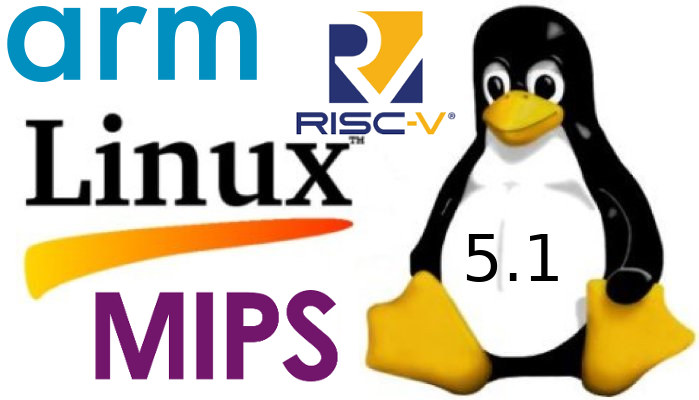I find most new phones’ announcements rather boring, but Motorola One Vision is somewhat interesting as it’s one of the rare non-Samsung phones to features an Exynos processor, more specifically Exynos 9609 which has not been seen in any other smartphones so far. Its other highlight is the 48MP camera sensor normally found in premium phones, and not in a 299 Euros device. Motorola One Vision specifications: SoC – Samsung Exynos 7609 octa-core processor with 4x Cortex-A73 @ 2.2GHz, 4x Cortex-A53 @ 1.6GHz, and Arm Mali G72MP3 System Memory – 4GB LPDDR4 Storage – 128GB internal storage, microSD card slot Display – 6.3″ LCD touch screen display with 2520 x 1080 resolution (21:9 aspect ratio) Camera 48MP rear camera with OIS based on IMX586 sensor 5MP Depth sensor 25MP front-facing camera Audio – 3.5mm headphone jack Wireless connectivity Cellular – 1x nanoSIM + 1x nanoSIM/microSD hybrid 802.11ac Wave 2 Wi-Fi […]
e.Foundation to Sell Refurbished Phones Running Google-Free /e/ Android OS
Most Android phones come with Google services, which is both a boon and a curse, as those services are often convenient, but they come at the loss of your privacy. For example, most people get all upset and lost if a firmware image for an SBC is shipped without Google Play Store, but yet at the same time they worry about their privacy providing all their data to a single company like Google. There must be a better way, and that’s what the e.foundation is attempting with /e/ operating system based on Android, but without any of the Google Services, and targetting your typical end-users, as opposed to geek. /e/ operating system aims to provide privacy both inside the phone, and via cloud services unrelated to Google. It is a fork of LineageOS 14.1 itself a fork of AOSP, and replaces Google services and apps with programs such as MicroG […]
Linux 5.1 Release – Main Changes, Arm, MIPS & RISC-V Architectures
Linus Torvalds has just announced the release of Linux 5.1: So it’s a bit later in the day than I usually do this, just because I was waffling about the release. Partly because I got some small pull requests today, but mostly just because I wasn’t looking forward to the timing of this upcoming 5.2 merge window. But the last-minute pull requests really weren’t big enough to justify delaying things over, and hopefully the merge window timing won’t be all that painful either. I just happen to have the college graduation of my oldest happen right smack dab in the middle of the upcoming merge window, so I might be effectively offline for a few days there. If worst comes to worst, I’ll extend it to make it all work, but I don’t think it will be needed. Anyway, on to 5.1 itself. The past week has been pretty calm, […]
Batocera.Linux OS Combines Kodi & Retro Gaming for Raspberry Pi & ODROID Boards
There are already several ways to run retro games on development boards, with for example RetroPie, and derivatives like RetrOrangePi, Lakka and Recalbox. Batocera.Linux is another option that I had never heard about so far, and works on PCs, as well as Raspberry Pi and ODROID boards, with ODROID-N2 support having been added very recently. batocera.linux operating system can easily be run from a USB flash drive on your computer without altering your existing OS, while it will boot from a standard microSD card on Raspberry Pi and ODROID boards. Beside retro-gaming support, the OS also includes Kodi media center for playing videos, or listening to music. You may even play games in it since retro-gaming support was added in Kodi 18. The partial compatibility table above shows all platforms have a different level of support, and for Intel hardware support more emulators than Arm based boards. The Orange arrow […]
Linux 5.0 Release – Main Changes, Arm, MIPS & RISC-V Architectures
Linus Torvalds has just released Linux 5.0: Ok, so the last week of the 5.0 release wasn’t entirely quiet, but it’s a lot smaller than rc8 was, and on the whole I’m happy that I delayed a week and did an rc8. It turns out that the actual patch that I talked about in the rc8 release wasn’t the worrisome bug I had thought: yes, we had an uninitialized variable, but the reason we hadn’t immediately noticed it due to a warning was that the way gcc works, the compiler had basically initialized it for us to the right value. So the same thing that caused not the lack of warning, also effectively meant that the fix was a no-op in practice. But hey, we had other bug fixes come in that actually did matter, and the uninitialized variable _could_ have been a problem with another compiler. Regardless – all […]
Samsung Galaxy S10, S10+, S10e, S10 5G Launched with Snapdragon 855 or Exynos 9820 SoC
Samsung officially launched the long awaited Galaxy S10 smartphone yesterday sporting either a Qualcomm Snapdragon 855 or Samsung Exynos 9820 processor coupled with 8GB RAM, 128 to 512GB storage, and a 6.1″ display. There are actually four variants of Galaxy S10, with S10+ model coming with up to 12GB RAM, 1TB flash storage, and a 6.4″ display, S10e phone with a smaller 5.8″ display, as low as 6GB RAM, and 128 to 256GB flash storage, and S10 5G with a 5G modem, a larger 6.7″ display, 6 cameras, and a larger 4,500 mAh battery. Many consider Samsung Galaxy phones to be the reference when it comes to Android phones, so let’s have a look at the technical specifications and features to see if there’s anything really new beside more processing power, and memory. Galaxy S10, S10+, S10e, and S10 5G phones share many of the same specifications: SoC (one or […]
Samsung Exynos 7904 Processor Enables Triple Camera Photography on Mid-Range Smartphones
Samsung has just introduced Exynos 7 Series 7904 (aka Exynos 7904) processor designed to bring better photography to mid-range smartphones thanks to an image signal processor supports single-camera resolution of up to 32-megapixels and a triple-camera setup. Samsung Exynos 7904 specifications: CPU – Dual-core Cortex-A73 up to 1.8 GHz, and hexa-core Cortex-A53 up to 1.6 GHz GPU – Mali-G71 MP2 Storage – eMMC 5.1 flash Memory – LPDDR4x Display – Up to Full HD+ (2400×1080) Camera – Rear 32MP, Front 32MP, Dual Camera 16MP+16MP Video – Up to 4K 30fps encoding and decoding with HEVC/H.265), H.264 and VP8, and decoding with VP9 LTE Modem – LTE Cat. 12 3CA 600Mbps (DL) / Cat.13 2CA 150Mbps (UL) Connectivity – Wi-Fi 802.11ac, Bluetooth 5.0, FM Radio GNSS – GPS, GLONASS, BeiDou, Galileo Process – 14nm FinFET Process Some of the key photography features made possible by the processor are explained in the […]
Samsung Exynos Auto V9 Octa-core Cortex A76 Processor Targets Automotive Infotainment Systems
Samsung Exynos processors are well known for their use in mobile processor, but the company has now announced their first automotive grade processor with Exynos Auto V9 SoC featuring eight Cortex A76 cores clocked at up to 2.1 GHz, a Mali G76 GPU, a HiFi 4 audio digital signal processor (DSP), an intelligent neural processing unit (NPU), and a safety island core that supports Automotive Safety Integrity Level (ASIL)-B standards. Exynos Auto V9 does not come with the latest Cortex-A76AE cores for autonomous driving, as instead the processor is specifically designed for in-vehicle infotainment (IVI) systems, and will be found in Audi cars starting in 2021. The processor also supports LPDDR4 and LPDDR5 DRAM, can control up to six independent displays and twelve cameras. Three separate sets of Mali G76 GPU cores will enable simultaneous support for the cluster display, central information display (CID) and rear-seat entertainment (RSE). The NPU […]










